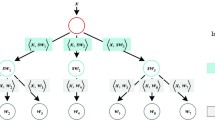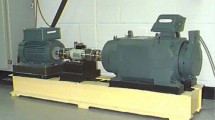Abstract
Deep neural networks (DNNs) for intelligent machinery fault diagnosis require a large amount of training data, powerful computational facilities and have many hyper-parameters that have to be carefully tuned to ensure maximum performance. Deep forest, as a novel alternative to the deep learning framework, has the potential to overcome these shortcomings. In this study, a deep forest-based end-to-end intelligent fault diagnosis method is proposed for hydraulic turbine, in which multi-grained scanning is first used to transform fault feature representations from raw data and enhance fault feature learning ability, and then cascade structure is constructed with different types of random forests to learn fault features level by level and classify faults. The effectiveness of the proposed method is validated using the experimental dataset under twelve conditions, and its practicability is validated using a simulated dataset generated by adding white Gaussian noise to raw experimental signals. The results show that the proposed method is able to adaptively mine available fault features from measured signals, and its diagnosis accuracy is better than that obtained by existing methods. More importantly, the proposed method has better robustness to noise and is less limited to the number of training data.
Similar content being viewed by others
References
G. Song, Y. He, F. Chu and Y. Gu, HYDES: A web-based hydro turbine fault diagnosis system, Expert Systems with Applications, 34 (2008) 764–772.
Y. Lei, Z. He and Y. Zi, A new approach to intelligent fault diagnosis of rotating machinery, Expert Systems with Applications, 35 (2008) 1593–1600.
P. Li, F. Kong, Q. He and Y. Liu, Multiscale slope feature extraction for rotating machinery fault diagnosis using wavelet analysis, Measurement, 46 (2013) 497–505.
Y. Lei, Z. He and Y. Zi, Application of an intelligent classification method to mechanical fault diagnosis, Expert Systems with Applications, 36 (2009) 9941–9948.
M. Sohaib, C.-H. Kim and J.-M. Kim, A hybrid feature model and deep-learning-based bearing fault diagnosis, Sensors, 17 (2017) 2876.
M. Luo, C. Li, X. Zhang, R. Li and X. An, Compound feature selection and parameter optimization of ELM for fault diagnosis of rolling element bearings, ISA Transactions, 65 (2016) 556–566.
R. Razavi-Far, H. Davilu, V. Palade and C. Lucas, Modelbased fault detection and isolation of a steam generator using neuro-fuzzy networks, Neurocomputing, 72 (2009) 2939–2951.
C. Li, R.-V. Sánchez, G. Zurita, M. Cerrada and D. Cabrera, Fault diagnosis for rotating machinery using vibration measurement deep statistical feature learning, Sensors, 16 (2016) 895.
Y. Lei, J. Li, Z. He and M. J. Zuo, A review on empirical mode decomposition in fault diagnosis of rotating machinery, Mechanical Systems and Signal Processing, 35 (2013) 108–126.
S. Rajagopalan, J. A. Restrepo, J. M. Aller, T. G. Habetler and R. G. Harley, Nonstationary motor fault detection using recent quadratic time-frequency representations, IEEE Transactions on Industry Applications, 44 (3) (2008) 735–744.
L. Meng, J. Xiang, Y. Wang, Y. Jiang and H. Gao, A hybrid fault diagnosis method using morphological filtertranslation invariant wavelet and improved ensemble empirical mode decomposition, Mechanical Systems and Signal Processing, 50–51 (2015) 101–115.
P. Konar and P. Chattopadhyay, Bearing fault detection of induction motor using wavelet and support vector machines (SVMs), Appl. Soft Comput., 11 (2011) 4203–4211.
S. P. Harsha, P. K. Kankar and S. C. Shar, Rolling element bearing fault diagnosis using wavelet transform, Neurocomputing, 74 (2011) 1638–1645.
F. Hemmati, W. Orfali and M. S. Gadala, Roller bearing acoustic signature extraction by wavelet packet transform, applications in fault detection and size estimation, Applied Acoustics, 104 (2016) 101–118.
J.-D. Wu and C.-H. Liu, An expert system for fault diagnosis in internal combustion engines using wavelet packet transform and neural network, Expert Systems with Applications, 36 (2009) 4278–4286.
J. B. Ali, N. Fnaiech, L. Saidi, B. Chebel-Morello and F. Fnaiech, Application of empirical mode decomposition and artificial neural network for automatic bearing fault diagnosis based on vibration signals, Applied Acoustics, 89 (2015) 16–27.
Y. Lei, N. Li, J. Lin and S. Wang, Fault diagnosis of rotating machinery based on an adaptive ensemble empirical mode decomposition, Sensors, 13 (2013) 16950–16964.
Z. Shen, X. Chen, X. Zhang and Z. He, A novel intelligent gear fault diagnosis model based on EMD and multi-class TSVM, Measurement, 45 (2012) 30–40.
Y. X. Wang, R. Markert, J. W. Xiang and W. G. Zheng, Research on variational mode decomposition and its application in detecting rub-impact fault of the rotor system, Mech. Syst. Signal Process, 60–61 (2014) 243–251.
M. Barakat, F. Druaux, D. Lefebvre, M. Khalil and O. Mustapha, Self adaptive growing neural network classifier for faults detection and diagnosis, Neurocomputing, 74 (2011) 3865–3876.
E. A. Mohamed, A. Y. Abdelaziz and A. S. Mostafa, A neural network-based scheme for fault diagnosis of power transformers, Electric Power Systems Research, 75 (2005) 29–39.
A. Schwung, M. Beck and J. Adamy, Fault diagnosis of dynamical systems using recurrent fuzzy systems with application to an electrohydraulic servo axis, Fuzzy Sets and Systems, 277 (2015) 138–153.
T. Wang, J. Qi, H. Xu, Y. Wang, L. Liu and D. Gao, Fault diagnosis method based on FFT-RPCA-SVM for cascaded-multilevel inverter, ISA Transactions, 60 (2016) 156–163.
Y. Xiao, N. Kang, Y. Hong and G. Zhang, Misalignment fault diagnosis of DFWT based on IEMD energy entropy and PSO-SVM, Entropy, 19 (2017) 6.
Y. Lan, J. Hu, J. Huang, L. Niu, X. Zeng, X. Xiong and B. Wu, Fault diagnosis on slipper abrasion of axial piston pump based on extreme learning machine, Measurement, 124(2018) 378–385.
F. Jia, Y. Lei, L. Guo, J. Lin and S. Xing, A neural network constructed by deep learning technique and its application to intelligent fault diagnosis of machines, Neurocomputing, 272 (2018) 619–628.
M. He and D. He, Deep learning based approach for bearing fault diagnosis, IEEE Transactions on Industry Applications, 53 (3) (2017) 3057–3065.
J. Huang, X. Hu and F. Yang, Support vector machine with genetic algorithm for machinery fault diagnosis of high voltage circuit breaker, Measurement, 44 (2011) 1018–1027.
B. Li, P. Zhang, H. Tian, Shuang-shan, D. Liu and G. Ren, A new feature extraction and selection scheme for hybrid fault diagnosis of gearbox, Expert Systems with Applications, 38 (2011) 10000–10009.
B. Samanta, Gear fault detection using artificial neural networks and support vector machines with genetic algorithms, Mechanical Systems and Signal Processing, 18 (3) (2004) 625–644.
R. Ahila, V. Sadasivam and K. Manimala, An integrated PSO for parameter determination and feature selection of ELM and its application in classification of power system disturbances, Applied Soft Computing, 32 (2015) 23–37.
V. Sugumaran, V. Muralidharan and K. I. Ramachandran, Feature selection using decision tree and classification through proximal support vector machine for fault diagnostics of roller bearing, Mechanical Systems and Signal Processing, 21 (2) (2007) 930–942.
Y. Lei, Z. He, Y. Zi and X. Chen, New clustering algorithm-based fault diagnosis using compensation distance evaluation technique, Mechanical Systems and Signal Processing, 22 (2) (2008) 419–435.
Y. Lei and M. J. Zuo, Gear crack level identification based on weighted K nearest neighbor classification algorithm, Mechanical Systems and Signal Processing, 23 (5) (2009) 1535–1547.
W. Deng, R. Yao, H. Zhao, X. Yang and G. Li, A novel intelligent diagnosis method using optimal LS-SVM with improved PSO algorithm, Soft Computing, 2–4 (2017) 1–18.
Z. Liu, H. Cao, X. Chen, Z. He and Z. Shen, Multi-fault classification based on wavelet SVM with PSO algorithm to analyze vibration signals from rolling element bearings, Neurocomputing, 99 (1) (2013) 399–410.
Y. Bengio and H. Lee, Editorial introduction to the neural networks special issue on deep learning of representations, Neural Networks, 64 (2015) 1–3.
G. E. Dahl, D. Yu, L. Deng and A. Acero, Context-dependent pre-trained deep neural networks for large-vocabulary speech recognition, IEEE Trans. Audio, Speech Lang. Process., 20 (2012) 30–42.
O. Russakovsky, J. Deng, H. Su, J. Krause, S. Satheesh, S. Ma, Z. H. Huang, A. Karpathy, A. Khosla, M. Bernstein, A. C. Berg and L. Fei-Fei, ImageNet large scale visual recognition challenge, International J. of Computer Vision, 115 (3) (2015) 211–252.
F. Jia, Y. Lei, J. Lin, X. Zhou and N. Lu, Deep neural networks: A promising tool for fault characteristic mining and intelligent diagnosis of rotating machinery with massive data, Mechanical Systems and Signal Processing, 72–73 (2016) 303–315.
O. Janssens, V. Slavkovikj, B. Vervisch, K. Stockman, M. Loccufier, S. Verstockt, R. Van de Walle and S. Van Hoecke, Convolutional neural network based fault detection for rotating machinery, J. of Sound & Vibration, 377 (2016) 331–345.
H. Shao, H. Jiang, H. Zhang, W. Duan, T. Liang and S. Wu, Rolling bearing fault feature learning using improved convolutional deep belief network with compressed sensing, Mechanical Systems & Signal Processing, 100 (2018) 743–765.
Z. H. Zhou and J. Feng, Deep forest: Towards an alternative to deep neural networks, Proceedings of the Twenty-Sixth International Joint Conference on Artificial Intelligence (IJCAI-17) (2017) 3553–3559.
G. Hu, H. Li, Y. Xia and L. Luo, A deep Boltzmann machine and multi-grained scanning forest ensemble collaborative method and its application to industrial fault diagnosis, Computers in Industry, 100 (2018) 287–296.
Y. Guo, S. Liu, Z. Li and X. Shang, BCDForest: A boosting cascade deep forest model towards the classification of cancer subtypes based on gene expression data, BMC Bioin-formatics, 19 (5) (2018) 118.
Author information
Authors and Affiliations
Corresponding author
Additional information
Recommended by Associate Editor Doo Ho Lee
Xiaolian Liu is a Ph.D. candidate in Sichuan University, who received the B.E. and M.E in hydraulic engineering from the Sichuan University, in 2013 and 2016, respectively. Her current research interests include hydraulic simulation, artificial intelligence and fault diagnosis.
Yu Tian is a Senior Engineer of China Institute of Water Resources and Hydropower Research (IWHR), who received the B.E. degree, M.E and Ph.D. in hydraulic engineering from the Tianjin University, Tianjin, China, in 2007, 2009 and 2012, respectively. She is with The China Institute of Water Resources and Hydropower research since 2012. Her current research interests include intelligent water resources management, hydraulic simulation, water resources regulation, big data analysis, and artificial intelligence.
Xiaohui Lei earned his Ph.D. from University of Tsukuba in water environment restoration in 2007. He now works in the Water Resources Department of IWHR as a Professorate Senior Engineer and the Director of Water Resources Regulation Office. Since then, Lei’s researches are focused on the operation of reservoirs and inter basin water diversions.
Mei Liu is a Senior Engineer of China Eastern Route Corporation of South-to-North Water Diversion, with a Ph.D. in Environmental science from the Beijing Normal University, Beijing, China, in 2012. She has been in Tsinghua University postdoctoral research station in 2013–2016. Her current research interests include water resources management, water resources regulation, and water environment management.
Xin Wen is currently an Associate Professor at the College of Water Conservancy and Hydropower Engineering at Hohai University. His research and technology transfer activities include multiple water projects operation, climate changes assessment and adaption, wind-solar-hydro hybrid energy system planning and optimization.
Wang Hao finished his Ph.D. at Tsinghua University in 1989. He is an eminent expert in hydrology and water resources, He currently heads the State Key Laboratory of Water Cycle Simulation and Regulation, and Department of Water Resources, China Institute of Water Resources and Hydropower Research.
Haocheng Huang is a Master’s candidate at Wuhan University. His current research interests are fluid machinery and hydraulic transient.
Rights and permissions
About this article
Cite this article
Liu, X., Tian, Y., Lei, X. et al. Deep forest based intelligent fault diagnosis of hydraulic turbine. J Mech Sci Technol 33, 2049–2058 (2019). https://doi.org/10.1007/s12206-019-0408-9
Received:
Revised:
Accepted:
Published:
Issue Date:
DOI: https://doi.org/10.1007/s12206-019-0408-9




